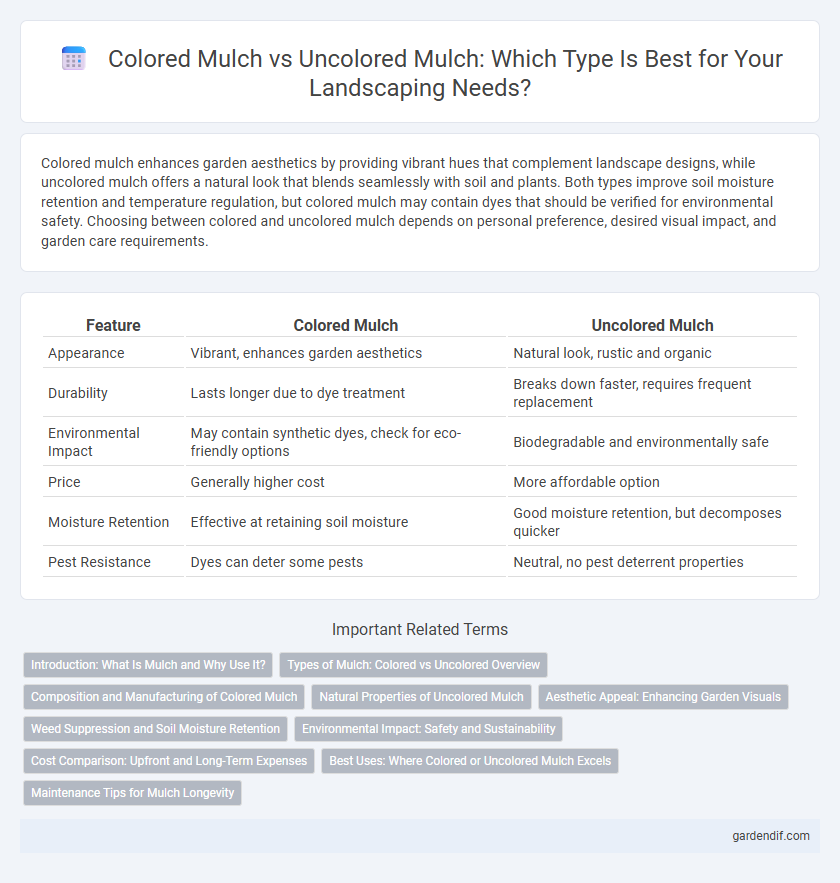
Colored Mulch vs Uncolored Mulch Illustration
Colored mulch enhances garden aesthetics by providing vibrant hues that complement landscape designs, while uncolored mulch offers a natural look that blends seamlessly with soil and plants. Both types improve soil moisture retention and temperature regulation, but colored mulch may contain dyes that should be verified for environmental safety. Choosing between colored and uncolored mulch depends on personal preference, desired visual impact, and garden care requirements.
Table of Comparison
| Feature | Colored Mulch | Uncolored Mulch |
|---|---|---|
| Appearance | Vibrant, enhances garden aesthetics | Natural look, rustic and organic |
| Durability | Lasts longer due to dye treatment | Breaks down faster, requires frequent replacement |
| Environmental Impact | May contain synthetic dyes, check for eco-friendly options | Biodegradable and environmentally safe |
| Price | Generally higher cost | More affordable option |
| Moisture Retention | Effective at retaining soil moisture | Good moisture retention, but decomposes quicker |
| Pest Resistance | Dyes can deter some pests | Neutral, no pest deterrent properties |
Introduction: What Is Mulch and Why Use It?
Mulch is a protective layer of organic or inorganic materials spread over soil to conserve moisture, regulate temperature, and suppress weeds. Colored mulch is typically dyed using safe, non-toxic pigments to enhance aesthetic appeal, while uncolored mulch retains its natural, earthy tones. Both types improve soil health by decomposing organic matter and providing nutrients, making mulch essential for sustainable gardening and landscaping.
Types of Mulch: Colored vs Uncolored Overview
Colored mulch enhances garden aesthetics by providing vibrant hues like red, brown, or black, which resist fading and help define landscape design. Uncolored mulch, typically made from natural bark, wood chips, or shredded leaves, offers a more organic appearance and gradually decomposes to enrich soil fertility. Both types effectively retain moisture, regulate soil temperature, and suppress weeds, but choosing between them depends on visual preference and garden style.
Composition and Manufacturing of Colored Mulch
Colored mulch is primarily composed of hardwood or softwood chips treated with non-toxic, water-based dyes that adhere to the surface without affecting the organic properties of the wood. Its manufacturing process involves shredding raw wood material, drying it to reduce moisture content, followed by thorough application of pigment to ensure even coloration and durability against weathering. Unlike uncolored mulch, which is produced by simply shredding and screening wood debris without additives, colored mulch requires precise dye formulation and quality control to maintain environmental safety and aesthetic consistency.
Natural Properties of Uncolored Mulch
Uncolored mulch maintains its natural composition, allowing it to retain essential properties such as moisture retention, temperature regulation, and soil enrichment without chemical additives. Its organic structure promotes beneficial microbial activity and gradual decomposition, improving soil health and nutrient availability. Unlike colored mulch, uncolored mulch avoids potential chemical leaching, making it an eco-friendly option for sustainable landscaping.
Aesthetic Appeal: Enhancing Garden Visuals
Colored mulch offers vibrant hues that boost garden charm and complement various plant palettes, creating striking visual contrasts. Uncolored mulch provides a natural, rustic look that blends seamlessly with landscapes for a subtler, organic aesthetic. Choosing between colored and uncolored mulch depends on desired garden style, with colored options elevating curb appeal and uncolored ensuring a classic, earthy tone.
Weed Suppression and Soil Moisture Retention
Colored mulch, typically made by adding organic dyes to hardwood or softwood chips, offers effective weed suppression by blocking sunlight and creating a dense barrier that inhibits weed seed germination. Uncolored mulch, often composed of natural bark or wood chips, also suppresses weeds but may provide less long-term coverage due to faster decomposition and lighter color reflecting sunlight. Both types significantly enhance soil moisture retention by reducing evaporation, though colored mulch can maintain cooler soil temperatures and moisture levels longer through increased surface shading and durability.
Environmental Impact: Safety and Sustainability
Colored mulch, often treated with synthetic dyes and chemicals, can pose environmental risks such as leaching harmful substances into soil and water, potentially affecting plant health and local ecosystems. Uncolored mulch, typically made from natural wood chips or bark without added chemicals, offers a safer, more sustainable option by promoting soil health and biodegrading without introducing pollutants. Choosing uncolored mulch supports eco-friendly gardening practices and reduces the long-term environmental footprint associated with landscape maintenance.
Cost Comparison: Upfront and Long-Term Expenses
Colored mulch typically incurs higher upfront costs due to the additives and dyes used in its production, often ranging from $4 to $8 per cubic yard, while uncolored mulch is generally more affordable, averaging $2 to $5 per cubic yard. Over time, colored mulch may require more frequent replacement or re-coloring to maintain its vibrant appearance, increasing long-term expenses compared to uncolored mulch, which naturally decomposes without aesthetic maintenance. Landscaping professionals often recommend considering both material costs and maintenance frequency when evaluating budget efficiency for mulching projects.
Best Uses: Where Colored or Uncolored Mulch Excels
Colored mulch excels in decorative landscaping, providing vibrant visual appeal in flower beds, playgrounds, and garden paths while helping retain soil moisture and suppress weeds. Uncolored mulch is best suited for naturalistic settings, vegetable gardens, and areas where soil enrichment is prioritized, as it breaks down more quickly and adds organic matter to the soil. Choosing between colored or uncolored mulch depends on aesthetic goals versus ecological benefits and soil health enhancement.
Maintenance Tips for Mulch Longevity
Colored mulch requires regular reapplication every 1-2 years to maintain its vibrant appearance because the dye fades due to sun exposure and weather conditions. Uncolored mulch typically lasts longer but benefits from periodic turning and replenishing to prevent compaction and promote moisture retention. Both types need weed barrier installation and proper watering practices to extend mulch longevity and enhance landscape health.
Colored Mulch vs Uncolored Mulch Infographic

 gardendif.com
gardendif.com